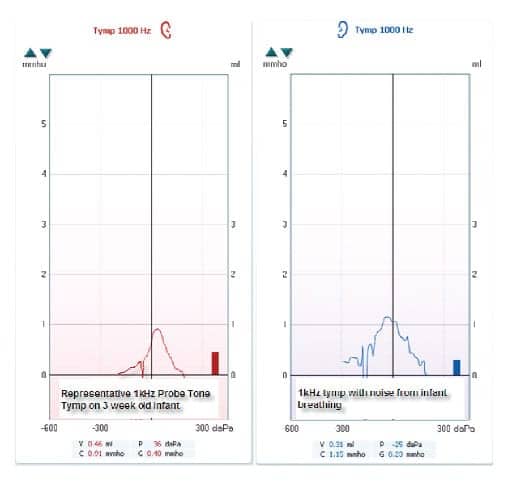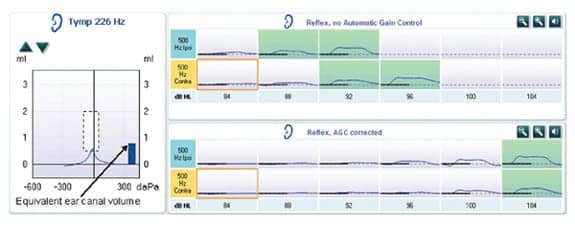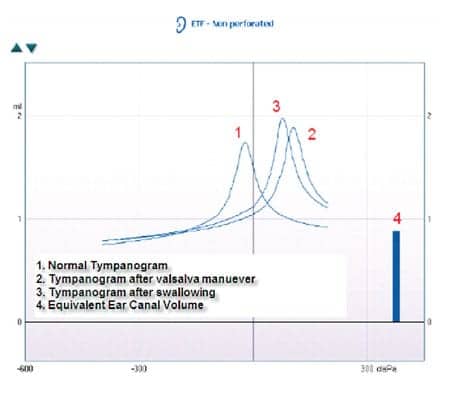Although many hearing care professionals depend on tympanometry to provide a “snapshot” of the middle ear status, there are many applications of this core technology beyond simple screening.
In conjunction with the 2009 introduction of the Interacoustics Titan—a handheld wireless, Bluetooth enabled clinical impedance bridge that allows quick screenings as well as comprehensive diagnostic tests—we thought it would be useful to review common middle ear measures, as well as improvements and upgrades available via the Titan. Therefore, this article reviews the utility of 1000 Hz stimulus probe tones for tympanograms in newborns and babies under 6 months of age, the use of Automatic Gain Control (AGC) to avoid excessive stimulus levels during acoustic reflex tests, as well as Eustachian tube tests, fistula tests, and related matters.

|

|

|

|
| This article was submitted to HR by Douglas L. Beck, AuD, director of professional relations at Oticon Inc, Somerset, NJ; David P. Speidel, MS, director of audiology services at Interacoustics Inc, Eden Prairie, Minn; Jos Huijnen, MSc, audiological consultant for Interacoustics A/S, Assens, Denmark; and Michelle R. Petrak, PhD, director of clinical audiology at Interacoustics Inc. Correspondence can be addressed to HR at [email protected] or Douglas L. Beck at . | |||
The Audiologic Diagnostic Profile
It can be argued the foundation of physiologic middle ear assessment is built on the tympanogram. This reasonably simple measure is quick, accurate, and easy to obtain and provides a quick “snapshot” of the overall status of the middle ear.
However, the tympanogram is only one component of a comprehensive test battery. In isolation, tympanograms do not provide enough information to accurately diagnose the middle ear system. Indeed, the utility of the tympanogram increases exponentially when considered in tandem with the entire audiologic diagnostic profile.
Tympanograms
The tympanogram is a representation of the sound pressure present in the cavity between the probe tip and the tympanic membrane as the pressure within the cavity is changed from about +200 to -300 decapascals (daPa). However, in the case of a perforated tympanic membrane, the cavity expands to include the middle ear space. Standard tympanograms use a 226 Hz probe tone presented at 69 dBHL. Because adult middle ear systems are “stiffness dominated” at lower frequencies and have high resonant frequencies, the 226 Hz tone is a good choice to evaluate adult ears.
However, newborns have middle ears that are “mass dominated.” Further, newborns have lower resonant frequencies,1 rendering the 226 Hz probe tone inefficient with regard to acquiring tympanograms on newborns.
Impedance generally refers to the opposition of energy flow. Low impedance occurs when air pressure medial and distal to the tympanic membrane (ie, on both sides) is equal. This same state (low impedance) is referred to as maximum compliance. In other words, the middle ear system is theoretically maximally compliant when the total equivalent volume of the cavity is the combined outer and middle ear volume (see Clark, Roeser, and Mendrygal2).
Tympanograms are most often acquired in accordance with international standards. As such, the primary features of the tympanogram are the peak pressure of maximal compliance (for adults usually between -100 and +50 daPa), the compliance at the peak of the tympanogram (which represents the total equivalent volume), and the overall shape or gradient (sometimes referred to as the tympanogram width). A quick and efficient “snapshot” of the acquired tympanogram is often based on the Jerger3 classification system, which employs types A, B, and C to describe the most common tympanograms (see Gelfand4).
1000 Hz tympanograms and newborns. The Antenatal and Newborn Screening Programs5 in the United Kingdom has recommended 1000 Hz probe-tone tympanometry for babies under 6 months. The Joint Committee on Infant Hearing6 also recommends tympanograms using a 1000 Hz probe tone for babies under 6 months of age.
Newborn screenings are most often accomplished using auditory brainstem response (ABR) and otoacoustic emissions (OAEs). Standard (226 Hz tone) tympanometry has not been clinically useful for identifying middle ear effusion (MEE) in newborns due to limited sensitivity and specificity. However, recent studies (discussed below) have demonstrated improved sensitivity and specificity in identifying middle ear effusion in newborns while using a 1000 Hz probe tone.
Using TEOAE and ABR as the “gold standard,” Baldwin7 reported 1000 Hz tympanometry has a sensitivity of 0.99, specificity of 0.89, and concluded that 1000 Hz tympanograms with a positive peak are consistent with normal middle ear function.
Shahnaz, Miranda, and Polka8 evaluated 91 newborns across three experiments evaluating multi-frequency tympanometry (MFT) in well babies, NICU babies, and those in the high risk register. They reported standard 226 Hz probe-tone tympanometry was often multi-peaked, thus offering limited information with regard to MEE. Nonetheless, they noted tympanograms acquired using a 1000 Hz probe tone were potentially more sensitive and more specific with regard to middle ear status. They reported tympanometry based on a 1000 Hz probe tone is a good predictor of present versus absent transient evoked OAEs. Shahnaz and colleagues also noted that, for newborns who passed ABR and OAE screenings, the 1000 Hz tympanograms were bell-shaped, had single peaks, and were well defined (with very few exceptions). Likewise, in newborns who failed TEOAEs, 1000 Hz tympanograms were most often flat, widened, or multi-peaked.

|
| FIGURE 1. Left: Representative 1 kHz probe-tone tympanogram on a 3-week-old infant. Right: 1 kHz tympanogram with noise from infant breathing. |
Alaerts, Lutz, and Woulters9 evaluated probe-tone frequencies (226 and 1000 Hz) across six age groups (NICU babies, 0-3 months, 3-6 months, 6-9 months, 9-32 months, and adults). They determined 1000 Hz tympanometry was the better probe tone when assessing neonates through 3 months of age. For children less than 3 months of age, the 1000 Hz probe tone was easier to interpret and more reliable than 226 Hz. From 3 to 9 months, they found it was wise to use both 226 and 1000 Hz. For babies older than 9 months, they recommended the 226 Hz tone.
Kei et al10 evaluated 96 boys and 74 girls ages 1 to 6 days. All 170 neonates were healthy and normal. TEOAEs and 226 Hz and 1000 Hz probe-tone tympanograms were acquired. Of those, 122 passed the TEOAE in both ears. Of the same 122 neonates (244 ears), 225 ears (92.2%) demonstrated a single-peaked tympanogram in response to the 1000 Hz probe tone. Further, only 3 ears (1.2%) produced a double-peaked tympanogram with the 1000 Hz probe tone. Interestingly, 116 of the 244 ears (47.5%) demonstrated double-peaked tympanograms using the 226 Hz probe tone.
Automatic Gain Control (AGC) and Acoustic Reflex Measurements
Current standards (IEC60645-5, ISO 389) for impedance bridges dictate stimuli used for reflex measurements are to be calibrated in a 2cc coupler. The resultant calibrated stimulus is presented to the ear canal. However, even though the stimulus has been calibrated and standardized, the physical size and acoustic properties of ear canals vary from (and among) adults to (and among) newborns, as does the depth of insertion of the probe tip.4 This results in a sound pressure level (SPL) at the ear drum that is not necessarily the same as the dial setting on the impedance bridge, presenting multiple issues and dilemmas similar to “Real-Ear-to-Coupler-Differences” (RECD) in the pediatric and adult hearing aid literature.11
Presenting unintentionally loud signals to newborns (and others) is not acceptable with regard to hearing safety. Additionally, inaccurate test protocols negate the value of the information acquired. For example, if the volume of space between the probe and the ear drum is greater than 2cc, the previously calibrated SPL is attenuated. If the volume of space between the probe and the ear drum is less than 2cc, the SPL increases. Theoretically, as the total space (ie, cavity size) is halved, the SPL increases 6 dB. Therefore, presenting an intended stimulus of 90 dB into the newborn’s ear of 0.25cc may result in a presentation of 108 dB SPL. Further, if the intended stimulus is 95 dB, one might actually deliver 113 dBSPL.
When acquiring reflex measures with Titan, a software option allows Automatic Gain Control (AGC) to compensate for volume differences by activating an AGC function on the ipsilateral stimuli (Figure 2). This safety measure corrects the stimulus level to a safe intensity level for newborns, while facilitating more accurate measures across all ear canal sizes.

|
| FIGURE 2. Acoustic reflexes and the problem of ear canal volume between the probe and TM. In the upper panel, AGC is not engaged, allowing no correction for insertion depth or ear canal size. In the lower panel, AGC is engaged, allowing a more accurate determination of acoustic reflex threshold. |
Eustachian Tube Tests
Eustachian tube (ET) tests incorporate tympanometric measures to document and verify the status of the eustachian tube. ET tests are used to confirm suspected ET dysfunction secondary to otitis media, middle ear effusion, and other nasopharyngeal abnormalities such as a patent ET.
Reasonably “normal” tympanograms are required to test ET function. For example, if the middle ear pressure is noted to be less than or equal to approximately -150 daPa, or if the tympanogram is flat (immobile), it is unlikely a meaningful ET test can be performed. As with many clinical tests, local normative values should be determined and incorporated to best define “normal,” “positive,” and “negative” pressures (in terms of daPa) with respect to the specific equipment used.
Performance and interpretation of Toynbee Test. Assuming the tympanogram demonstrates an essentially normal presentation from approximately +50 to -150 daPa, the ET test can proceed. Generally, the starting point is to obtain a new tympanogram, note the pressure peak (in daPa), maintain the seal, and increase the pressure to +400 daPa. Next, have the patient hold their nose and swallow (referred to as the “Toynbee maneuver”) and then acquire a new tympanogram. If the ET is functioning normally, the new tympanogram pressure peak should shift (negatively) toward the normal pressure region. In other words, a normally functioning ET will allow the positive pressure to be normalized secondary to swallowing. The Toynbee maneuver can be repeated a few times, and with each repetition the tympanogram should continue to approach the original normal pressure, assuming the ET is functioning normally.
Performance and interpretation of Valsalva. The next step in the ET function test is to allow the patient to normalize their daPa pressure and obtain another tympanogram as a new “baseline” measure. Note the pressure peak (in daPa) and, while maintaining the seal, reduce the pressure to -300. Next, have the patient hold their nose and “blow” gently but firmly (Valsalva maneuver). If the ET is functioning normally, the tympanogram pressure peak should shift (positively) toward the normal pressure region (Figure 3). In other words, a normally functioning ET will allow the negative pressure to be normalized secondary to the Valsalva manuever. This maneuver can be repeated a few times, and the tympanogram should continue to approach the original baseline pressure, assuming the ET is functioning normally.

|
| FIGURE 3. Valsalva maneuver and interpretation. If the ET is functioning normally, the tympanogram pressure peak should shift (positively) toward the normal pressure region. |
Performance and interpretation of patulous ET. Normal, healthy ETs are closed during the vast majority of the time. Closure is maintained by cartilaginous elasticity, the mucosal lining, and surrounding muscles and fat. Patulous (abnormally open) eustachian tubes present frustrating problems for patients and clinicians. Conditions associated with patulous eustachian tubes include sudden weight loss, radiation therapy, hormonal changes and therapy, pregnancy, fatigue, stress, and, in some cases, inappropriate use of nasal decongestants.12 Although the incidence of patulous eustachian tubes is unknown, it has been estimated that perhaps between 5% and 30% of otherwise normal ears have patulous ETs, yet only 10% to 20% of those with the condition are bothered enough to seek diagnosis or treatment.12
Grimmer and Poe13 observed computed tomography (CT) scans showing loss of soft tissue within the cartilaginous portion of the ET in patients with patulous ETs. These patients present with an inability to completely close the ET. They complain they hear themselves breathing or may report hearing their heartbeat or other rhythmic internal sounds.
To determine if the ET is patulous, obtain a baseline tympanogram and maintain the seal, ask the patient to begin breathing slowly, and then ask the patient to gradually increase his or her breathing rate. If the ET is patulous, you may record a sinusoidal-appearing graphic pattern that correlates with breathing rate changes.
Another application of the same test is to witness volume displacement in tandem with the patient’s heartbeat. This same pattern may be evident with a glomus tumor situated within the middle ear. Synchrony with the patient’s heartbeat can be verified by measuring the radial pulse as the ET patency test is progressing. The software-driven Titan allows these tests to be executed quickly and efficiently.
Perilymph Fistula
Perilymph fistula (PLF) is an abnormal opening between the air-filled middle ear space and the fluid-filled inner ear. PLF may occur secondary to stapedectomy, head trauma, barotrauma, or cochlear congenital malformations, or may occur secondary to an increase in cerebrospinal fluid pressure.14 PLFs have been reported in the round window (RW), in the oval window (OW), and/or within the otic capsule.15 Most often, PLF occurs secondary to tears or defects in the membranous covering of the RW or the OW. Symptoms of PLF include fluctuating hearing loss, tinnitus, a feeling of fullness in the ear, and dizziness or vertigo.
Environmental air pressure does not impact normally healthy inner ears. For example, normally healthy ears “pop” to equalize pressure between the middle ear space and the external environment, such as while flying, mountain climbing, etc. However, when a fistula is present, changes in middle ear pressure directly impact the inner ear, stimulating the balance and/or hearing structures and causing PLF symptoms, which may include dizziness, vertigo, imbalance, nausea, and vomiting. People with fistulas sometimes note their symptoms get worse with coughing, sneezing, or blowing their noses.
Performing a PLF test. Applying positive pressure to a tympanic membrane in an ear with a fistula can produce nystagmus, resulting in a “positive” fistula test. A positive fistula result is identified by the production of nystagmus associated with changing pressure at the tympanic membrane. In some cases, the nystagmus can change direction as the pressure changes from positive to negative.
To accomplish this test, two instruments are preferred: an impedance bridge with manual override control (the Titan impedance bridge can manually control the change in air pressure and can hold the pressure at a desired value) and a video-nystagmography (VNG) system to record nystagmus. Typically, the impedance probe is placed in the ipsilateral test ear and the pressure is increased from 0 daPa to +200 daPa, held there for 20 seconds, and then gradually reduced to –200 daPa, maintained for 20 seconds, and then returned to 0 daPa. A VNG recording is collected during the entire test time and the recordings are analyzed for nystagmus.

|
|
Basic Tympanometry in the Dispensing Office, by Jay B. McSpaden, PhD. November 2006 HR. Using Acoustic Middle Ear Muscle Reflexes and Their Utility in Fitting Hearing Instruments, by Jay B. McSpaden, PhD. September 2008 HR. |
Discussion
Modern clinical impedance bridges provide flexibility, simplicity, and portability for screenings, as well as sophisticated software-driven protocols and options for maximal and comprehensive diagnostic applications. The Interacoustics Titan offers traditional screenings and diagnostic applications, while addressing the needs of the most sophisticated users with regard to 1000 Hz tympanometry, ipsilateral AGC reflexes, Eustachian tube tests, perilymph fistula tests, and more.
Although many hearing care professionals and health professionals depend on tympanometry to provide a “snapshot” of the middle ear status, there are many applications of this core technology beyond simple screening applications. Indeed, a thorough understanding of these tests and their applications can assist the clinician in determining a scientifically sound and well-documented differential diagnosis.
References
- Kei J, Mazlan R, Hickson L, Gavranich J, Linning R. Measuring middle ear admittance in newborns using 1000 Hz tympanometry: A comparison of methodologies. J Am Acad Audiol. 2007;18:739-748.
- Clark JL, Roeser RJ, Mendrygal M. Middle ear measures. In: Roeser R, Valente M, Hosford-Dunn H, eds. Audiology–Diagnosis. 2nd ed. New York: Thieme Publications; 2007:380-399.
- Jerger JF. Clinical experience with impedence audiometry. Arch Otolaryngol. 1970;92:311-324.
- Gelfand S. Essentials of Audiology. 2nd ed. New York: Thieme Publications; 2007:225.
- NHSP Clinical Group. Antenatal and Newborn Screening Programmes: Tympanometry in Babies Under 6 Months–A Recommended Test Protocol, Version 2. Available at: www.library.nhs.uk/ENT/ViewResource.aspx?resID=148626&tabID=288&summaries. Accessed March 25, 2009.
- Joint Committee on Infant Hearing (JCIH): Year 2007 Position Statement: Principles and Guidelines for Early Hearing Detection and Intervention Programs. Pediatrics. 2007;120(4):898-921.
- Baldwin M. Choice of probe tone and classification of trace patterns in tympanometry undertaken in early infancy. Intl J Audiol. 2006;45:417-427.
- Shahnaz N, Miranda T, Polka L. Multifrequency tympanometry in neonatal intensive care unit and well babies. J Am Acad Audiol. 2008;19:392-418.
- Alaerts J, Lutz H, Woulters J. Evaluation of middle ear function in young children: clincal guidelines for the use of 226 and 1000 Hz tympanometry. Otol Neurotol. 2007;28 (6):727-732.
- Kei J, Allison-Levick J, Dockray J, Harrys R, Kirkegard C, Wong J, Maurer M, Hegarty J, Young J, Tudehope D. High-frequency (1000 Hz) tympanometry in normal neonates. J Am Acad Audiol. 2003;14(1):20-28.
- Bohnert A, Brantzen P. RECD and clinical verification in children. Hearing Review. 2004;11(5):50-52.
- Henry DF, DiBartolomeo JR. Patulous eustachian tube identification using tympanomerty. J Am Acad Audiol. 1993;4:53-57.
- Grimmer JF, Poe DS. Update on eustachian tube dysfunction and the patulous eustachian tube. Curr Opin Otolaryngol Head Neck Surg. 2005;13(5):277-82.
- Castillo MP, Roland PS. Disorders of the auditory system. In: Roeser RJ, Valente M, Hosford-Dunn H, eds. Audiology: Diagnosis. 2nd ed. New York: Thieme Publishers; 2007:95.
- American Hearing Research Foundation. What is a Perilymph Fistula? Available at: www.american-hearing.org/disorders/unilat/perilymph_fistula.html#whatis. Accessed March 25, 2009.
Citation for this article:
Beck D, Speidel D, Huijnen J, Petrak M. Tympanometry and Acoustic Reflex: Innovation, Review, and Application. Hearing Review. 2009;16(4):28-33.





